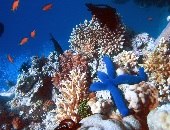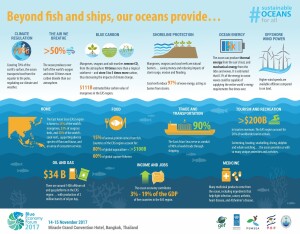“Oceans absorb one-third of carbon dioxide emissions. Yet projects connected to oceans are underfunded as per the UN Sustainable Development Goals (SDG),” said Tom Counsell,
Assistant Vice President at T. Rowe Price, a global investment management firm. “What is meant by the blue economy, and how can it help save the oceans?”
On December 10, 2024, Counsell welcomed an audience to a webinar, “The Rise of Blue Bonds and the Blue Economy,” featuring two panelists from the Chartered Financial Analysts Institute (CFA Institute) and T. Rowe Price.
Blue bonds are fixed-income financial instruments (bonds) issued specifically to finance ocean conservation and sustainable development.
“Oceans serve as the host to vital ecosystems, yet the UN SDG 6 and 14 are the most underfunded of the 17 sustainability goals,” said Matthew Lawton, Portfolio Manager at T. Rowe Price. “How can we address the funding gaps? This is where bond markets come in.” They can facilitate the flow of money to worthwhile projects.
The International Finance Corporation (IFC) is a member of the World Bank Group. A partnership between IFC and T. Rowe Price will launch a global blue bond strategy. Lawton said that T. Rowe Price has three objectives with blue bonds. First, to follow clients and innovation into the sustainability area. Second, he said, “There is tremendous opportunity to scale. We’re at the tipping point. We can hand select the best projects now.” Third, he said, “Capital can do more than just create alpha in partnership with the IFC, which has done good work with green bonds.”
The second panelist was Richard MacGillivray, Senior Director at CFA Institute. He said blue bonds are a subset of Green, Social and Sustainability (GSS) bonds and can include projects to provide fresh, clean water.
Confidence in blue bonds is evolving. “There are due diligence concerns to highlight,” MacGillivray said. “We must ensure comfort with the language of how to use the proceeds. Transparency is key. Potential issues relate to the income generation of assets and programs. Also, projects might not generate income so the role of the guarantor will be very important.” One example is the Seychelles blue bond of 2018, where the World Bank was a guarantor.
9 Funding Categories
The blue economy “spans everything from sanitation and clean water to the collection of plastics before they’re diverted into water sources,” Lawton said.
The IFC document on Blue Finance contains 9 categories of funding:
A. Water supply
C. Ocean-friendly and water-friendly products
D. Ocean-friendly chemicals and plastic-related sectors
E. Sustainable shipping and port logistics sectors
F. Fisheries, aquaculture, and seafood value chain
G. Marine ecosystem restoration
H. Sustainable tourism services
I. Offshore renewable energy production
Blue bonds are not a niche market. They cover quite a broad area, and issuers include TMB, a Thai-based company, Maersk, and Orsted.
“You have to look at the guarantor to determine the credit quality,” he said. “In times of volatility, these trade defensively. So they tend to have longer-term holding horizons.”
Comparing blue bonds with non-blue bonds from the same issuer, the blue bonds trade with a 10 to 15 basis point yield advantage.
For example, consider the World Bank bond for plastics reduction. It involves the countries of Ghana and Indonesia, and links well with impact investing. There are certain milestones set for this project, such as the time by when the collected plastics will be cleaned and changed into plastic pellets suitable for production.
Such a project “needs underwriting on the impact side as well as the monetization,” Lawton said. “If impact agendas are met, there’s AAA status plus 40 to 50 basis points.” He noted that World Bank has done a series of bonds, including wildlife protection, the Wildlife Conservation Bond.
Is there blue washing? To avoid the empty promises of greenwashing, Lawton suggested that investors look at the key performance indicators (KPIs) that are used to evaluate the success of a project. “We aggregate all the KPIs to the top of the line.”
Trends & Drivers
“We have an increasing appreciation for the role of the ocean, which is the largest carbon sink on Earth,” MacGillivray said.
“There are regional developments, supported by the CSRD,” he said, referring to the Corporate Sustainability Reporting Directive, a sustainability reporting regulation in the European Union. It applies to all European companies and operations, 60 to 75 percent of all companies in Europe.
Another trend, MacGillivray said, is the heightened interest in the blue economy and sustainability reflected in the CFA program. “Our enthusiasm is driven by an understanding of how material sustainability really is. CFA Level 1 readings include 350 percent more information on sustainability than they did pre-pandemic.” The size of audiences attending webinars explaining the new Climate Risk, Valuation, and Investing Certificate have risen from 6 to 600, compared to a year ago.
Emerging Markets
According to Lawton, when it comes to blue bonds for sub-Saharan Africa, the funding gap is more acute in emerging markets. Investor firms are looking for five-year BBB bonds, where the financial upside is higher. “The shipping industry is more influential in emerging markets,” he said. “Coastal adaptations and biodiversity are all linked to the blue economy.”
Upgrading the water utility infrastructure is also important to emerging markets, as well as sustainable aquaculture.
“Blue bonds are a good investment because defensive trading behavior will give you stability,” Lawton said. Blue bonds will support a secondary trading structure, in which the original, issuing companies are not involved.
Green and Blue
As marine biologist Sylvia Earle says, no green without blue.
“Issuing a blue bond is not a cost-less exercise,” Lawton said. “With blue bonds you will have a more water-intensive focus. This means enhancing your risk management. There are more demands for blue bonds and green bonds…. In fact, there is an oversubscription. This means market access and liquidity have improved markedly.”
Lawton noted that blue bonds are at a tipping point—“like green bonds were 10 to 15 years ago. Paris 2015 made everyone sit up and take notice. Now policy is on the COP agenda.” In November 2024, the COP29 UN Climate Conference agreed to triple finance commitments to developing countries, protecting lives and livelihoods.
“A high seas treaty will be ratified soon. We can ride the tailwinds. There’s interest and enthusiasm from underwriters and issuers. It translates into $100 billion more in emerging markets,” Lawton noted.
In the meantime, MacGillivray encourages financial professionals to consider specialized training. ♠️
The coral reef picture is by copyright (c) 2004 Richard Ling, CC BY-SA 3.0, https://commons.wikimedia.org/w/index.php?curid=78275
The blue bonds graphic is from the 2017 Blue Economy Forum run by Partnerships in Environmental Management for the Seas of East Asia (PEMSEA). Permission pending.




